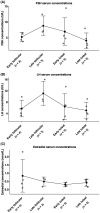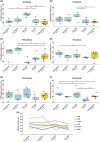Cyclic activity of signal transduction pathways in fimbrial epithelium of the human fallopian tube
- PMID: 34927235
- PMCID: PMC9564698
- DOI: 10.1111/aogs.14306
Cyclic activity of signal transduction pathways in fimbrial epithelium of the human fallopian tube
Abstract
Introduction: The local environment of the fallopian tube represents the optimal conditions for reproductive processes. To maintain tissue homeostasis, signal transduction pathways are thought to play a pivotal role. Enhancing our understanding of functional signal transduction pathway activity is important to be able to clarify the role of aberrant signal transduction pathway activity leading to female subfertility and other tubal diseases. Therefore, in this study we investigate the influence of the hormonal cycle on the activity of key signal transduction pathways in the fimbrial epithelium of morphologically normal fallopian tubes.
Material and methods: We included healthy pre- (n = 17) and postmenopausal (n = 8) patients who had surgical interventions for benign gynecologic conditions. Histologic sections of the fallopian tubes were reviewed by two pathologists and, for the premenopausal patients, hormone serum levels and sections of the endometrium were examined to determine the hormonal phase (early follicular [n = 4], late follicular [n = 3], early luteal [n = 5], late luteal [n = 5]). After laser capture microdissection, total mRNA was extracted from the fimbrial epithelium and real-time quantitative reverse transcription-PCR was performed to determine functional signal transduction pathway activity of the androgen receptor (AR), estrogen receptor (ER), phosphoinositide-3-kinase (PI3K), Hedgehog (HH), transforming growth factor-beta (TGF-β) and canonical wingless-type MMTV integration site (Wnt) pathways.
Results: The early luteal phase demonstrated high AR and ER pathway activity in comparison with the late luteal phase (p = 0.016 and p = 0.032, respectively) and low PI3K activity compared with the late follicular phase (p = 0.036), whereas the late luteal phase showed low activity of HH and Wnt compared with the early follicular phase (both p = 0.016). Signal transduction pathway activity in fimbrial epithelium from postmenopausal patients was most similar to the early follicular and/or late luteal phase with regard to the AR, ER and PI3K pathways. Wnt pathway activity in postmenopausal patients was comparable to the late follicular and early luteal phase. We observed no differences in HH and TGF-β pathway activity between pre- and postmenopausal samples. The cyclic changes in signal transduction pathway activity suggest a stage-specific function which may affect the morphology and physiology of the human fallopian tube.
Conclusions: We demonstrated cyclic changes in activity of the AR, ER, PI3K, HH and Wnt pathways throughout the hormonal cycle.
Keywords: computational models; fimbriae; hormonal cycle; human fallopian tube; signal transduction pathways.
© 2021 The Authors. Acta Obstetricia et Gynecologica Scandinavica published by John Wiley & Sons Ltd on behalf of Nordic Federation of Societies of Obstetrics and Gynecology (NFOG).
Conflict of interest statement
Phyllis van der Ploeg is an employee of the Catharina Hospital, where her research work is funded by the Catharina Research fund and Molecular Pathway. Dx, Philips. Anja van de Stolpe is an employee of Molecular Pathway Dx, Philips. The other authors declare no conflict of interest.
Figures


References
-
- Bahar‐Shany K, Brand H, Sapoznik S, et al. Exposure of fallopian tube epithelium to follicular fluid mimics carcinogenic changes in precursor lesions of serous papillary carcinoma. Gynecol Oncol. 2014;132:322‐327. - PubMed
-
- Maclean A, Bunni E, Makrydima S, et al. Fallopian tube epithelial cells express androgen receptor and have a distinct hormonal responsiveness when compared with endometrial epithelium. Hum Reprod. 2020;35:2097‐2106. - PubMed
MeSH terms
Substances
Grants and funding
LinkOut - more resources
Full Text Sources
Medical
Research Materials

